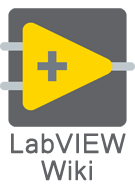LabVIEW Interface: Difference between revisions
Appearance
Clarify that interfaces may inherit from other interfaces |
Add recommendation for project libraries over interfaces for function libraries. |
||
| Line 12: | Line 12: | ||
==Best practice== | ==Best practice== | ||
* Do not use the leading "I" when naming interfaces.<ref name="lvi-decision"/> | * Do not use the leading "I" when naming interfaces.<ref name="lvi-decision"/> | ||
* Use a [[Project Library]] instead of default implementations in an interface to build function libraries. | |||
==History== | ==History== | ||
{| class="wikitable" | {| class="wikitable" | ||
Latest revision as of 08:03, 30 April 2020

LabVIEW Interface is a kind of class library that implements the concept of interfaces in LabVIEW. An interface defines a contract between the caller and the callee. Any class that inherits from an interface declares that it will provide all methods defined by that interface. In LabVIEW a class may have only one class parent and as many interface parents as it wants to have.[1] An interface may also inherit from one or more other interfaces.
Key features
- Interfaces use the same file extension as classes (*.lvclass).
- Interfaces have their own unique icon (
 ) in the Project Explorer.
) in the Project Explorer. - Interfaces use the same default ("chain") wire appearance as classes.
- Interfaces are created and changed using the same dialogs as classes.
- Interfaces can provide default implementations for their methods.
- Classes do not inherit the interface library icon or wire appearance.
- Call Parent Class Method cannot invoke interface parent methods.
Best practice
- Do not use the leading "I" when naming interfaces.[1]
- Use a Project Library instead of default implementations in an interface to build function libraries.
History
| Version | Change(s) |
|---|---|

|
Interfaces were added to LabVIEW |
See also
References
- ↑ 1.0 1.1 LabVIEW Interfaces: The Decisions Behind the Design by AristosQueue
| |
This article is a stub. You can help LabVIEW Wiki by expanding it. Please improve this article if you can. |
